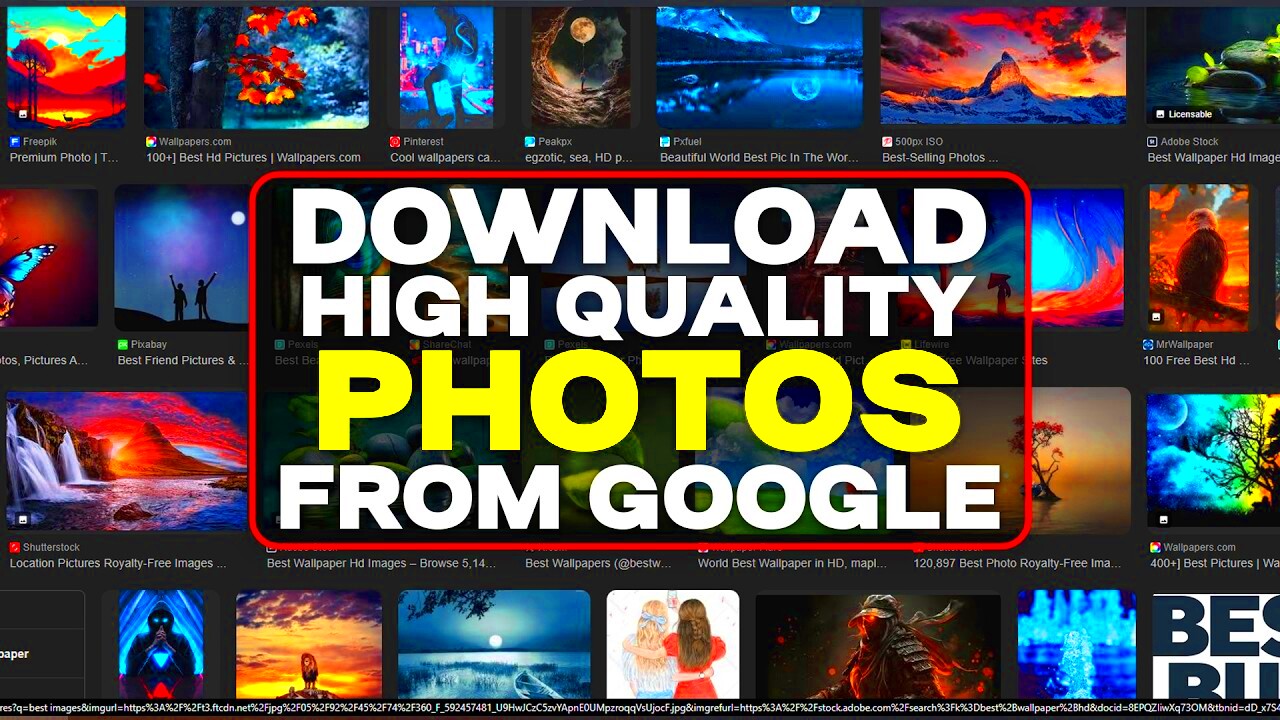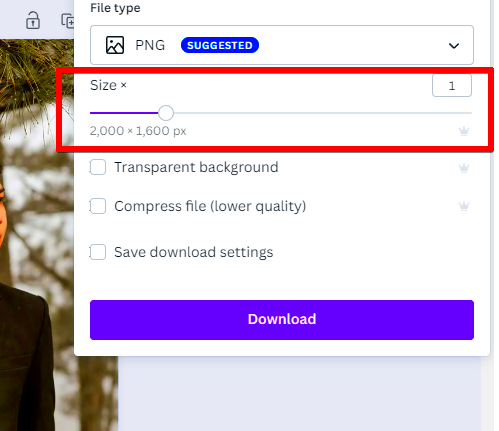When working on digital projects, whether it's for web design, social media, or printing, the quality of the images you use can make a significant difference. High-resolution images provide clarity, sharpness, and detail that make your work stand out. In this post, we’ll talk about the importance of downloading high-resolution images and guide you through the process, especially focusing on using Dribbble image downloader. If you're looking to download the best quality images for your projects, you’re in the right place!
Why You Need High Resolution Images

High-resolution images are essential for a variety of reasons. Let’s take a closer look at why they should be a priority for your projects:
- Clear and Crisp Visuals: High-resolution images provide more detail and sharpness, which makes them perfect for professional projects like marketing materials, websites, and presentations.
- Better for Printing: If you're planning to print your images, higher resolution ensures they don’t appear pixelated or blurry when enlarged. Images with 300 DPI (dots per inch) are ideal for print quality.
- Optimized for Scaling: High-res images maintain their quality even when resized, unlike lower resolution images that lose clarity when stretched.
- Improved User Experience: Websites with sharp, clear images attract and retain visitors, making high-quality images a vital part of your online presence.
Ultimately, high-resolution images help create more professional, polished, and engaging content, whether it’s for online or offline use. Having access to these images is crucial if you want your projects to shine.
Also Read This: How to Get an API for Behance WordPress Plugin
Steps to Download High Resolution Images Using Dribbble Image Downloader

Downloading high-resolution images from Dribbble using their image downloader tool is easy and straightforward. Follow these simple steps to get the images you need:
- Step 1: Find the Image
Visit Dribbble and search for the image you want to download. Dribbble is known for its high-quality creative work, so you're sure to find some excellent visuals. - Step 2: Copy the Image URL
Once you've found the image you want, right-click on it and select “Copy image address” or “Copy link.” This will give you the direct link to the image file. - Step 3: Open the Dribbble Image Downloader
Go to the Dribbble image downloader tool on the website. Paste the copied URL into the tool’s input field. - Step 4: Download the Image
Click on the "Download" button. The tool will automatically fetch the high-resolution version of the image, and you’ll be able to save it to your device.
That’s it! The Dribbble image downloader tool makes it easy to get the best quality images in just a few clicks. It’s a simple and fast way to ensure you’re working with high-resolution visuals for your projects.
Also Read This: Find Out If Being a Contributor on Shutterstock Is Safe for My Photos
Common Issues When Downloading Images and How to Fix Them
Downloading images online is usually a smooth process, but sometimes things don't go as planned. If you've ever tried downloading an image only to face unexpected issues, you're not alone. Here are some common problems users face and how to fix them:
- Issue 1: Image Not Downloading Properly
If the image doesn't download, it could be due to a broken link or slow internet connection. Double-check the image link, and ensure your connection is stable. If the link is still valid, try downloading from a different browser. - Issue 2: Low-Resolution Image Downloaded
Sometimes, tools may download the wrong version of the image, typically a lower resolution. Ensure you're using a reliable image downloader that specifies high-resolution images. If you're using the Dribbble image downloader, it will fetch the best quality available. - Issue 3: Image is Not in the Correct Format
Occasionally, you may download an image in an unsupported or unexpected format (like .webp). Use online tools or software like Photoshop to convert it into a more common format like .jpg or .png. - Issue 4: File Too Large to Download
If the image is too large for your device, it could be due to your storage or browser restrictions. Try clearing your browser cache or downloading the image on a different device with more storage space.
These common issues can be easily fixed with a bit of troubleshooting. Understanding what causes the problem can save you time and help you download the images you need efficiently.
Also Read This: Understanding the Costs of Running a YouTube Channel
Benefits of Using a Dribbble Image Downloader
The Dribbble image downloader tool is a great resource for anyone looking to download high-quality images from Dribbble. Here’s why it’s beneficial to use this tool:
- Access to High-Quality Images:
Dribbble is a platform known for its high-resolution creative work. By using a downloader tool, you get access to the best quality images without any hassle. - Time-Saving:
Instead of manually saving images one by one from Dribbble, the image downloader allows you to download them quickly in a few steps. This is especially useful if you need several images at once. - Easy to Use:
The Dribbble image downloader is user-friendly and simple to navigate, making it accessible for both beginners and experienced designers alike. - Free Tool:
Most Dribbble image downloaders are free to use, which means you don’t have to worry about paying for a tool or subscription. - Consistent Image Quality:
With a downloader, you can ensure that the image you are getting is the correct high-resolution version, maintaining its sharpness and clarity for your projects.
Whether you’re working on web design, marketing materials, or other creative projects, using the Dribbble image downloader can streamline your process and help you access quality images with ease.
Also Read This: Understanding the Importance of Adobe Stock
How to Choose the Right Images for Your Projects
Choosing the right images for your project is crucial for creating visually appealing and effective content. Here’s how you can make the best image selections:
- Consider the Purpose:
Start by thinking about the purpose of the image. Is it for a website, blog, social media, or a print project? The image should complement the message you want to convey and fit the format of your work. - Resolution Matters:
Ensure the image is of high resolution, especially if it will be printed. For web use, images with 72 DPI (dots per inch) are suitable, but for print, aim for at least 300 DPI for clear, sharp visuals. - Relevance:
Choose images that are relevant to the content or theme of your project. A mismatch between image and content can confuse your audience or detract from your message. - Brand Alignment:
If you are working on a project for a brand, ensure that the images align with the brand's colors, style, and tone. Consistency in visual elements is key to maintaining brand identity. - Avoid Overused Stock Images:
Using generic or overused stock images can make your project feel less original. Try to find unique images or customize them to make them fit your project better. - Image Licensing:
Before downloading or using an image, make sure it’s either free to use or properly licensed. Many platforms, including Dribbble, offer licensing details for the images they feature.
By keeping these tips in mind, you can choose images that not only look great but also work well with your project goals, enhancing your overall design and message.
Also Read This: How to Sell Android Photos on Alamy: A Comprehensive Guide
Alternative Ways to Download High Resolution Images
While Dribbble is a fantastic platform for high-quality images, there are plenty of other ways to find and download high-resolution images. Whether you're looking for images for a personal project or something more professional, here are some alternative methods and platforms you can explore:
- Stock Image Websites:
Stock image platforms like Unsplash, Pexels, and Pixabay offer a large variety of high-resolution images for free. These sites are particularly popular among creatives looking for high-quality images with no cost involved. However, always check the license to ensure you're allowed to use them for your specific purpose. - Creative Commons Search:
If you need images that are free to use and modify, Creative Commons offers a vast collection. You can search for images under the Creative Commons license, which allows for both personal and commercial use, depending on the type of license. - Google Advanced Image Search:
Google's Advanced Image Search is another way to find high-resolution images. You can filter the results by size, color, and usage rights to ensure you’re downloading the right kind of image for your project. Just be sure to respect copyright and usage guidelines. - Paid Stock Image Services:
For those willing to pay for premium images, websites like Shutterstock, Adobe Stock, and Getty Images provide access to a huge library of high-resolution images. These platforms typically offer the most exclusive and professional content, but at a cost. - Social Media and Design Communities:
Many platforms like Behance and DeviantArt feature high-quality images from designers and photographers. While some of these images are free to use, others may require permission or licensing agreements. Always check the terms before downloading.
These alternatives give you a wide variety of options to access high-resolution images, whether you're working on a personal project or something professional. Just be mindful of licensing and usage rights when downloading images from any source.
Also Read This: How to Download Getty Images Without Watermark: A Tutorial
Conclusion
In conclusion, downloading high-resolution images is easier than ever with the right tools and knowledge. Whether you're using Dribbble’s image downloader or exploring other platforms like Unsplash, Pexels, or paid stock image services, there are plenty of options available to meet your needs. High-resolution images are essential for creating professional, visually stunning content, and now you know the best ways to access them quickly and easily.
Remember to always check the licensing and usage rights for the images you download to avoid any legal issues. By following the tips and steps outlined in this guide, you’ll be able to enhance your projects with high-quality images that capture attention and communicate your message effectively.
FAQ
Q1: How do I know if an image is high-resolution?
To check if an image is high-resolution, look at its DPI (dots per inch). For print, the ideal resolution is at least 300 DPI, and for web use, 72 DPI is generally sufficient. You can also check the image's dimensions in pixels; larger images (e.g., 3000x2000px) are typically higher in resolution.
Q2: Can I use images from Dribbble for commercial projects?
Not all images on Dribbble are free to use for commercial purposes. Many creators upload their work for personal use only, so always check the image's licensing and usage terms before using it in commercial projects. If unsure, contact the creator for permission.
Q3: Are there free alternatives to Dribbble for high-resolution images?
Yes, websites like Unsplash, Pexels, and Pixabay offer free high-resolution images that you can use for both personal and commercial projects. However, always check the licensing to ensure you're using the image appropriately.
Q4: Can I download images from Dribbble without an account?
Yes, you can download images from Dribbble without an account. However, having an account allows you to interact with creators, follow your favorite designers, and save images for later use.
Q5: What do I do if I can't find a high-resolution version of an image?
If you can't find a high-resolution version of an image on Dribbble or any other platform, consider contacting the creator directly to ask if they can provide a higher resolution version. Alternatively, explore other platforms that specialize in high-res images like Adobe Stock or Shutterstock.











